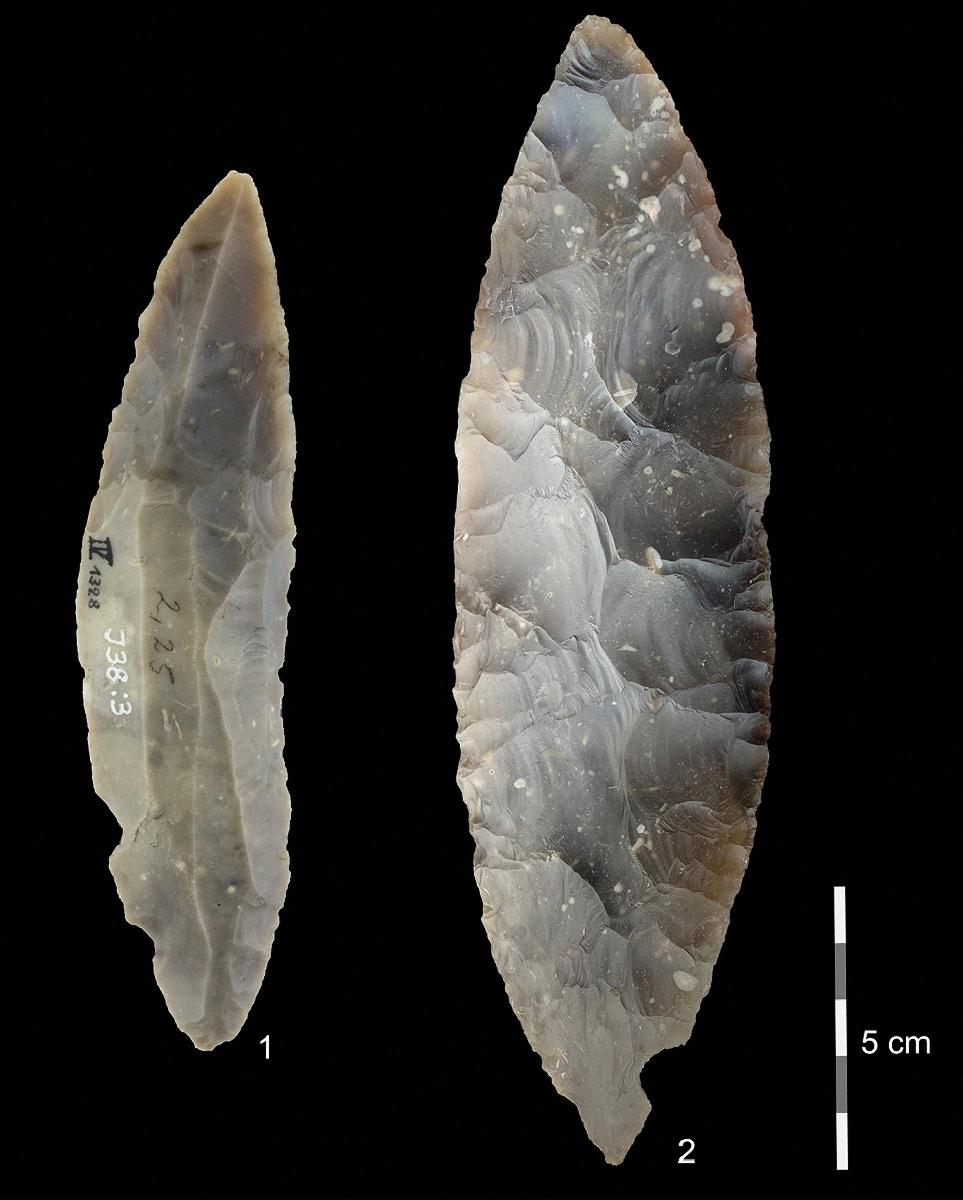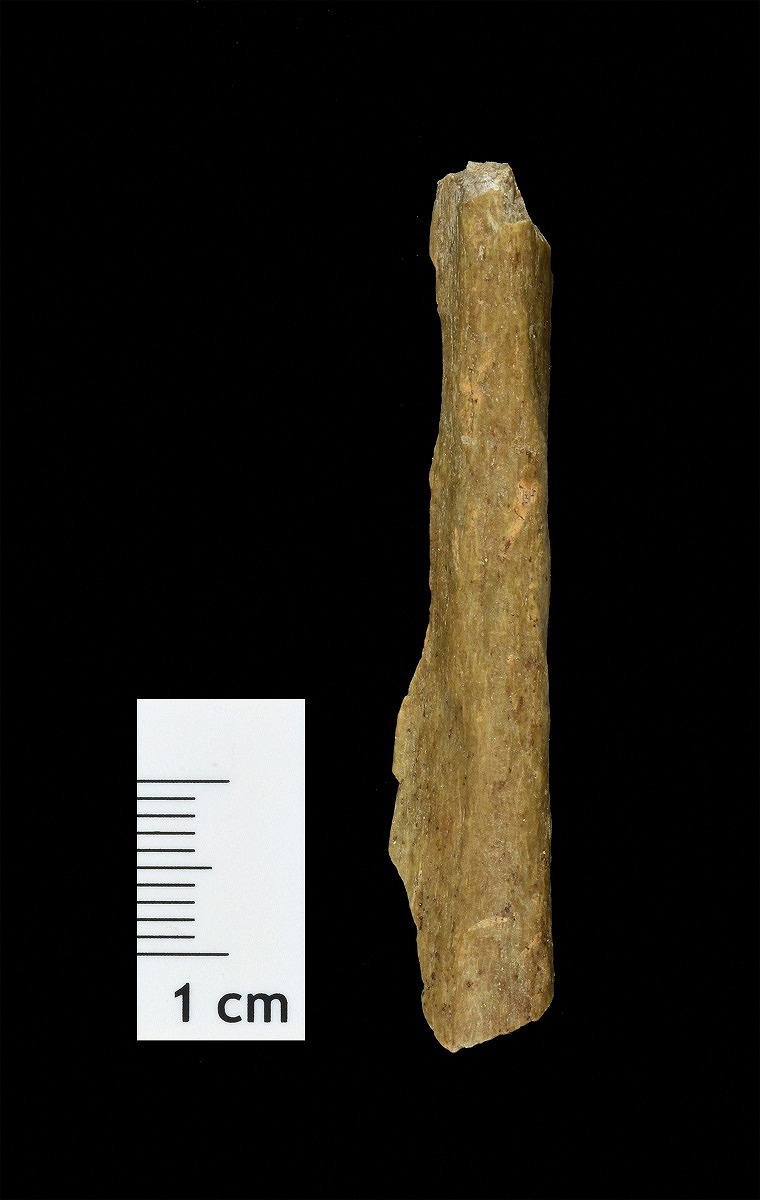
Stone tools excavated from Ilsenhohle cave in the German town of Ranis are seen in a composite image in this undated photo.
11:56 JST, February 17, 2024
Bone fragments unearthed in a cave in central Germany show that our species ventured into Europe’s cold higher latitudes more than 45,000 years ago — much earlier than previously known — in a finding that rewrites the early history of Homo sapiens on a continent still inhabited then by our cousins the Neanderthals.
Scientists said on Jan. 31 they identified through ancient DNA 13 Homo sapiens skeletal remains in Ilsenhohle cave, situated below a medieval hilltop castle in the German town of Ranis. The bones were determined to be up to 47,500 years old. Until now, the oldest Homo sapiens remains from northern central and northwestern Europe were about 40,000 years old.
“These fragments are directly dated by radiocarbon and yielded well preserved DNA of Homo sapiens,” said paleoanthropologist and research leader Jean-Jacques Hublin of College de France in Paris.
Homo sapiens arose in Africa more than 300,000 years ago, later trekking worldwide and encountering other human populations, including Neanderthals. The spotty fossil record has left unclear the details of how Homo sapiens spread through Europe and what role our species played in the extinction of Neanderthals, who disappeared roughly 40,000 years ago.
The research, presented in three studies published in the journals Nature and Nature Ecology & Evolution, showed that the region was colder then than now — a chilly steppe-tundra setting akin to modern-day Siberia or Scandinavia — illustrating how Homo sapiens, despite roots in warmer Africa, adapted relatively quickly to frigid conditions.
The researchers concluded that small, mobile bands of hunter-gatherers used the cave sporadically as they roamed a landscape teeming with Ice Age mammals, and that at other times it was occupied by cave hyenas and cave bears.
“The site in Ranis was occupied during several short-term stays, and not as a huge camp site,” said archaeologist Marcel Weiss of Friedrich-Alexander-Universitat Erlangen-Nurnberg in Germany, another of the research leaders.
Bones and stone artifacts from the cave showed that these people hunted large mammals including reindeer, horses, bison and woolly rhinoceroses.
“It is interesting that the diet of both these early Homo sapiens and late Neanderthals appears to be focused on large terrestrial game, which could have led to areas of competition,” said zooarchaeologist Geoff Smith of the University of Kent, who led one of the studies. “However, we still need additional data points to more fully understand the role and impact of climate and incoming Homo sapiens groups in the eventual extinction of Neanderthals in Europe.”
The research appeared to resolve a debate over who made a specific set of European stone artifacts — attributed to what is called the Lincombian-Ranisian-Jerzmanowician (LRJ) culture — including leaf-shaped stone blades useful as spear tips for hunting. Many experts had hypothesized these were fashioned by Neanderthals. Their presence at Ranis with no evidence of Neanderthals instead indicates they were made by Homo sapiens.
“These blade points have been found from Poland and Czechia, over Germany and Belgium, into the British Isles, and we can now assume they most likely represent an early presence of Homo sapiens all over this northern region,” Smith said.
The researchers identified the bones based on mitochondrial DNA, which reflects maternal heredity. More can be learned through nuclear DNA, offering genetic information from both parents, including perhaps whether Homo sapiens at Ranis interbred with Neanderthals.
The cave was excavated in the 1930s, with bones and stone artifacts found, before World War II interrupted the work. Technology at the time could not identify the bones. Researchers reexcavated it from 2016 to 2022, uncovering more bones and artifacts. DNA sequencing on newly found and previously unearthed bones identified Homo sapiens remains.
“The results for Ranis are amazing,” Weiss said, adding that scientists should return to other European sites from this time period to check for similar evidence of an early Homo sapiens presence.

A Homo sapiens bone fragment is seen in a composite image in this undated photo.
"Science & Nature" POPULAR ARTICLE
-

Mass Oyster Die-Offs Confirmed in Japan’s Seto Inland Sea; High Water Temperature Cited as Primary Cause
-

Genome Study Reveals Milestone in History of Cat Domestication
-

Big Leap in Quest to Get to Bottom of Climate Ice Mystery
-

Security Camera Footage Vulnerable to Outside Access; Investigation Finds 3,000 Pieces Exposed Online
-

Paws on Parade: Nairobi’s Dogs Dazzle at ‘Pawchella’
JN ACCESS RANKING
-

Keidanren Chairman Yoshinobu Tsutsui Visits Kashiwazaki-Kariwa Nuclear Power Plant; Inspects New Emergency Safety System
-

Imports of Rare Earths from China Facing Delays, May Be Caused by Deterioration of Japan-China Relations
-

University of Tokyo Professor Discusses Japanese Economic Security in Interview Ahead of Forum
-

Japan Pulls out of Vietnam Nuclear Project, Complicating Hanoi’s Power Plans
-

Govt Aims to Expand NISA Program Lineup, Abolish Age Restriction























